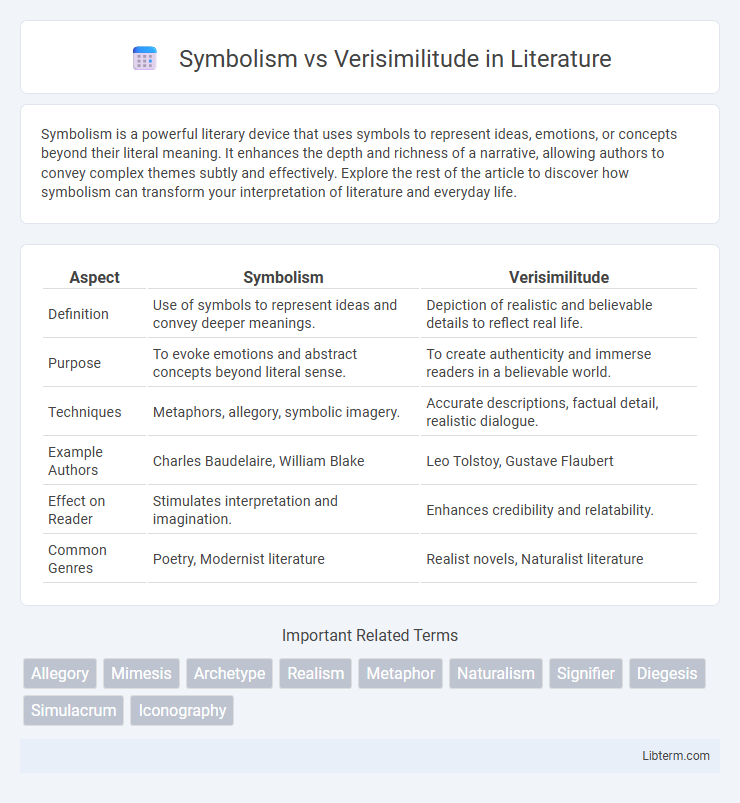Symbolism is a powerful literary device that uses symbols to represent ideas, emotions, or concepts beyond their literal meaning. It enhances the depth and richness of a narrative, allowing authors to convey complex themes subtly and effectively. Explore the rest of the article to discover how symbolism can transform your interpretation of literature and everyday life.
Table of Comparison
| Aspect | Symbolism | Verisimilitude |
|---|---|---|
| Definition | Use of symbols to represent ideas and convey deeper meanings. | Depiction of realistic and believable details to reflect real life. |
| Purpose | To evoke emotions and abstract concepts beyond literal sense. | To create authenticity and immerse readers in a believable world. |
| Techniques | Metaphors, allegory, symbolic imagery. | Accurate descriptions, factual detail, realistic dialogue. |
| Example Authors | Charles Baudelaire, William Blake | Leo Tolstoy, Gustave Flaubert |
| Effect on Reader | Stimulates interpretation and imagination. | Enhances credibility and relatability. |
| Common Genres | Poetry, Modernist literature | Realist novels, Naturalist literature |
Understanding Symbolism in Literature
Symbolism in literature involves using symbols--objects, characters, or events--to represent broader ideas and convey deeper meanings beyond the literal narrative. This technique enriches the text by adding layers of interpretation and engaging readers in exploring abstract concepts through concrete elements. Understanding symbolism requires recognizing these symbolic elements and interpreting their significance within the cultural, historical, and contextual framework of the work.
Defining Verisimilitude: Realism in Art
Verisimilitude in art refers to the quality of realism that convincingly represents life or truth, emphasizing accurate depiction of subjects, settings, and emotions. It prioritizes detailed observation and faithful reproduction to create an immersive experience that aligns closely with the viewer's understanding of reality. Unlike symbolism, which conveys abstract ideas through metaphor, verisimilitude aims to reflect the tangible and observable world with precision and clarity.
Historical Roots of Symbolism and Verisimilitude
Symbolism originated in the late 19th century as a reaction against realism, emphasizing subjective experience and abstract ideas through symbols rather than direct representation. Verisimilitude, rooted in classical literature and Renaissance humanism, strives to create lifelike, plausible narratives that reflect reality and human behavior. Both concepts evolved to address different artistic goals: Symbolism seeks deeper metaphysical truths, while Verisimilitude prioritizes authenticity and detail in storytelling.
Key Differences Between Symbolism and Verisimilitude
Symbolism uses abstract symbols and metaphors to convey deeper meanings beyond the literal narrative, emphasizing emotional and conceptual interpretation. Verisimilitude prioritizes realism and factual accuracy, creating a convincing and believable representation of life or events. Key differences include symbolism's reliance on subjective interpretation versus verisimilitude's objective portrayal of reality.
The Role of Symbolism in Storytelling
Symbolism in storytelling creates deeper layers of meaning by using objects, characters, or events to represent abstract ideas, enriching the narrative beyond literal interpretation. It engages readers by evoking emotions and themes, allowing for multiple interpretations that resonate on a psychological or cultural level. Unlike verisimilitude, which prioritizes realistic detail, symbolism enhances thematic depth and invites audiences to uncover hidden significance within the story.
Verisimilitude: Crafting Believable Worlds
Verisimilitude in storytelling emphasizes creating believable worlds through consistent internal logic, realistic characters, and plausible events that immerse readers in a coherent narrative. This technique relies on detailed descriptions, authentic dialogue, and relatable emotions to foster suspension of disbelief, allowing audiences to engage deeply with the fictional universe. By prioritizing manifold sensory experiences and verifiable details, verisimilitude enhances the credibility and emotional impact of the narrative environment.
Symbolic Language vs. Realistic Dialogue
Symbolic language employs metaphor, allegory, and abstraction to convey deeper themes and emotions beyond literal meaning, enriching the narrative with layered interpretations. Realistic dialogue mirrors everyday speech patterns and vernacular, grounding characters in authentic social and cultural contexts for immersive storytelling. Balancing symbolic language and realistic dialogue enhances both thematic complexity and relatable character development in literature and drama.
Impact on Reader Interpretation
Symbolism enriches reader interpretation by inviting multiple layers of meaning through metaphors and abstract representation, encouraging personal and emotional engagement. Verisimilitude prioritizes realism and factual accuracy, fostering reader trust and immersion by reflecting everyday experiences or plausible scenarios. The contrast between these literary devices shapes how readers perceive themes, either through imaginative exploration or grounded authenticity.
Famous Works Exemplifying Each Approach
"The Great Gatsby" by F. Scott Fitzgerald exemplifies symbolism through its use of the green light and the Valley of Ashes to represent hope and moral decay respectively. In contrast, Gustave Courbet's painting "The Stone Breakers" embodies verisimilitude by depicting peasants with gritty realism to emphasize everyday hardship. These works showcase how symbolism evokes abstract ideas, while verisimilitude aims for lifelike representation.
Choosing Between Symbolism and Verisimilitude in Creative Writing
Choosing between symbolism and verisimilitude in creative writing depends on the intended impact and narrative purpose; symbolism enriches a story by imbuing objects or actions with deeper meanings that resonate emotionally, while verisimilitude emphasizes realistic details to create a believable and immersive world. Writers prioritizing thematic depth and abstract connections benefit from symbolism, whereas those aiming for authenticity and relatability focus on verisimilitude to mirror real-life experiences accurately. Balancing these elements strategically enhances both the emotional resonance and credibility of the narrative.
Symbolism Infographic

 libterm.com
libterm.com